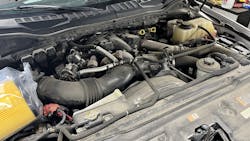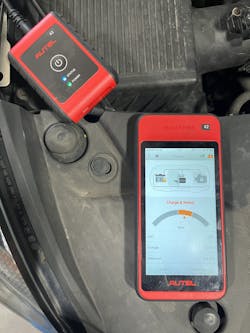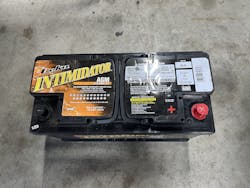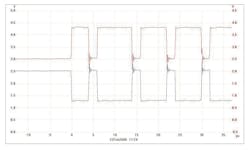Today’s battery and electrical system service
When it comes to today’s vehicles, stable voltage is incredibly important. On modern vehicles, just dirty battery terminals can cause drivability concerns. They can cause odd things with the vehicle’s operation from stalling just from poor contact at the battery terminals to communication issues and multiple trouble codes. When it comes to looking for this, a simple voltage drop test can be the best test to perform to find these types of problems. Due to the number of computers utilized in today’s vehicles, it is increasingly important to ensure proper charging system operation as well.
Diagnosing electrical concerns
Now, when it comes to diagnosing an electrical concern you should always start with a complete battery and charging system test. I am going to show my age in my next statement. I started so long ago that I learned to test batteries with carbon pile testers. They would load test the battery and generate quite a bit of heat as part of the test, hence the nickname toaster. Today’s battery testers (Figure 1) are conductance-type testers and do not load test the battery, instead, they test the internal resistance of the battery. The benefit of this type of tester is that the battery does not have to be fully charged in order to perform an accurate test. I have had the occasional battery that if you load tested it, it would fail but it would pass the conductance test. Those batteries have been the exception rather than the rule though.
The next step is to check the charging system for proper operation and voltage. As part of my charging system testing, I will typically turn on all the major loads in the vehicle and see where the voltage rests. If I do find a problem, I will begin by voltage drop testing the charging system. This is the fastest way to locate any type of issue you may have in the charging circuit.
The modern vehicle's battery
More and more vehicles are installing the battery in the trunk. The reason for this is to maintain the temperature of the battery more consistently. Being installed in the trunk, the battery is not exposed to the high underhood temperatures of the engine. But in so doing, the batteries have become more difficult to access and replace. Make sure to consult the labor guide for proper testing times on these applications.
Also, more and more vehicles are coming from the factory with AGM-style batteries. As you can see from Figure 2, the battery doesn’t look any different from a normal flooded LED cell battery, but don't let this similarity make you forget to reset the battery life cycle in the PCM. The purpose of doing this is to ensure the proper charge rate for the new battery. An aged AGM battery is going to have a more aggressive charge rate to maintain the proper charge level of the battery. If you do not reset battery life with a new AGM battery, it will dramatically decrease the life of the new battery. I have personally seen a new AGM battery where the battery life wasn’t reset, which caused the new battery to fail within two years.
Working with alternators
When it comes to alternators, there are plenty of things that can go wrong. From broken sprag clutches to bearing failure to bad voltage regulators. Make sure you understand the proper operation of the alternator that you are working with. Remember when using remanufactured alternators there is approximately a 14 percent return rate for all rotating electrical in the industry (Figure 3). Also, be sure to do a proper diagnosis of the complete charging system before condemning the alternator. There is nothing more frustrating than replacing a second alternator only to ultimately find it was something you missed during your initial diagnosis — especially when it is a 3-plus hour job.
I personally will install the new alternator and verify proper operation. If it is not operating properly, I will begin my diagnosis from the beginning to verify it is truly the replacement part and not an issue in the wiring or the PCM. Doing this could save you the aggravation of replacing the alternator again.
Voltage regulator
There are many different strategies used to control the voltage regulator of the alternator. Ford for example, when first started and with low RPM, the voltage regulation is handled by the alternator’s internal voltage regulator. Once the engine hits 1400 RPM the system switches over to the PCM for voltage regulation. This is accomplished by a pulse width modulated signal. There is a control and feedback from the alternator to the PCM. If either one of the wires breaks, the alternator’s internal voltage regulator will continue to handle the charging circuit, but you will have a red battery light on the dash. Keep in mind the red battery light will be off until you hit the 1400 RPM. Once you hit that RPM level the light will come on. The trick to repairing any of these charging systems is dependent on knowing the theory and operation of the system.
Diagnosing intermittent/constant problems
One of the first things I do when I am diagnosing a vehicle with either an intermittent or constant problem is to watch the voltage through the scanner as well as what the PCM is reporting. Obviously, if the concern is in another system look for the voltage PID in that module. You could have a voltage drop at a connector or even a damaged wire going to just that module. Do not forget when performing any testing to make sure that you have a good ground for accurate readings.
I try very hard not to use resistance tests unless I'm specifically testing a sensor. Think of a multi-strand wire connected to the headlight. If one strand is still making contact it will show good resistance readings. However, if you load test the circuit with the headlamp, the light will barely light, if at all. The wire simply cannot carry the amperage load through one strand. This is where voltage drop testing comes into play. You would pick up on that failure as soon as you tested that part of the circuit.
Case study 1: Ford F-550
We recently had a client’s vehicle in for an intermittent stalling concern on his Ford F-550. The complaint was described as he would be driving down the road and the truck would shut off for a split second and a few lights would come on, on the dashboard (Figure 4). The truck would slow down to approximately 35 mph and then restart, but the lights would remain on until the ignition was cycled.
Now, this client raced dirt track for years and recently performed a frame-off restoration on a Nova. He is very mechanically inclined but understood this was more than his capability. The very first thing we did was drive the vehicle, but we were unable to duplicate the problem. The next step was to perform a full vehicle scan to see what trouble codes popped up. The codes we found directly corresponded to a bulletin to replace the transmission wire harness for leaking into the external connector. Sure enough, we disconnected the connector and it was full of automatic transmission fluid.
We advised the client of our findings and actually showed him what we had found. He authorized the repair so we replaced the transmission internal wire harness and performed several long test drives to verify that that was the only problem. We logged over 50 miles on the vehicle with no problem. We contacted the client to let him know it was all set and he came and picked up the vehicle. Within half an hour the client texted me to let me know that the problem had reoccurred. That weekend he changed both batteries and he has logged over 1,400 miles on the truck since with no problems.
Case study 2: Dodge Challenger
Electrical faults can be some of the most difficult to find. We had a Dodge Challenger that only under certain conditions would the network shut down. If you drove the car normally it was fine. The client had taken the vehicle to the dealer a total of six times with them being unable to duplicate the problem. The client finally brought the vehicle to us.
We found that if you put all the heavy loads on in the vehicle and let it just sit and idle. The voltage would drop down to 11.5V and the problem would occur. It was easy to see because the windshield wiper blades would turn on by themselves. The network would go down and everything would default to a safety mode. The Challenger’s network is only CAN, there are no other networks on the vehicle, so the entire car would crash. On this vehicle, it ended up being the transmission control module. We determined this by connecting an oscilloscope to the network and began disconnecting modules from the bus bar until the network returned to normal.





